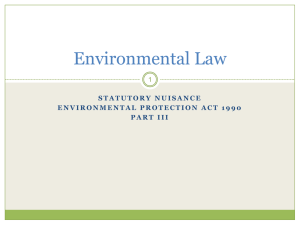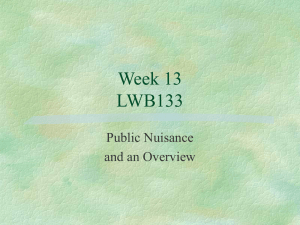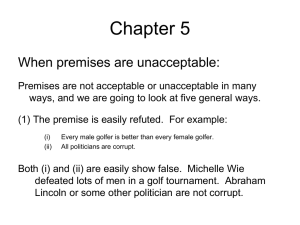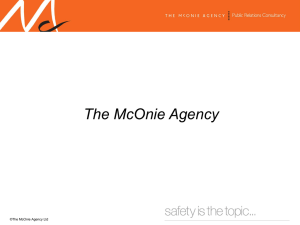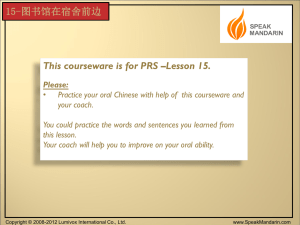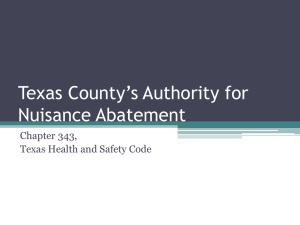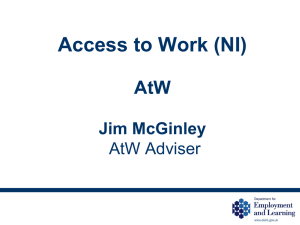final presentation slides
advertisement
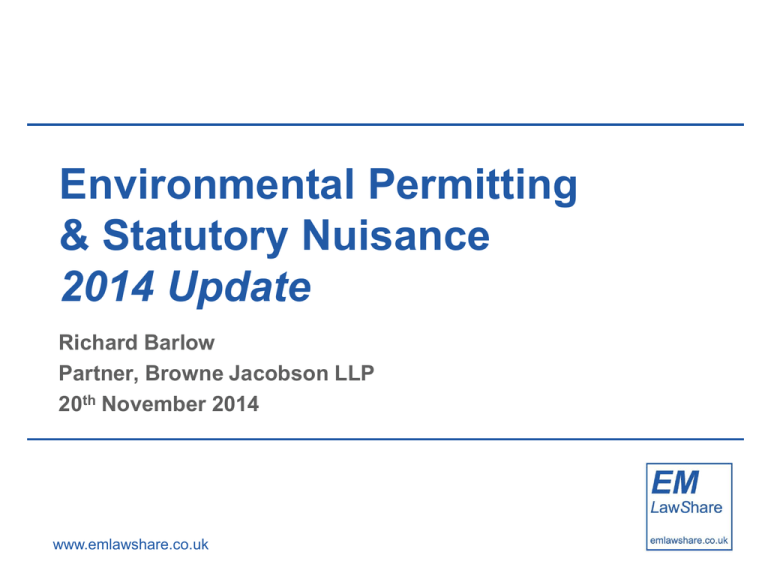
Environmental Permitting & Statutory Nuisance 2014 Update Richard Barlow Partner, Browne Jacobson LLP 20th November 2014 www.emlawshare.co.uk The EP Regime • Comprehensive regime introduced in 2008 • Integrated the regimes for: – Waste management licensing – Pollution prevention and control (“PCC”) • Extended in 2010 to cover: – Water discharge consents – Groundwater authorisations – Radioactive substances authorisations www.emlawshare.co.uk The EP Regime • Water Act 2014 gave powers to SoS and Welsh Ministers to make regulations to further extend EP regime to cover: – Water abstraction and water impounding licences – Flood defence consents – Fish pass approvals www.emlawshare.co.uk The Regulations • The main regulations: Environmental Permitting (England and Wales) Regulations 2010 (SI 2010/675) (EP Regulations 2010) • Came into force on 6 April 2010 • Amended a number of times • Schedules deal with permitting requirements of particular types of activity (implementing EU Directives) www.emlawshare.co.uk The Underlying Rationale • R (on the application of Rockware Glass Ltd) –vChester City Council (1) Quinn Glass Ltd (2) [2006] EWCA Civ 992 • EU Directive 96/61 1996 Purpose = “to control pollution by stringent measures…” www.emlawshare.co.uk What is a “regulated facility”? • A broad range of industrial installations (activities listed in Part 2 of Schedule 1) • Waste operations • Mining waste operations • Radioactive substances activities • Water discharge activities • Groundwater activities • Small waste incineration plants • Solvent emission activities www.emlawshare.co.uk Exempt facilities • Certain low-risk facilities are exempt (see Schedule 2 and 3 to EP Regs 2010) • Operators must register the exempt activity with the relevant regulator • Registrations will need to be renewed periodically www.emlawshare.co.uk EP guidance materials • Defra's Core Guidance (March 2013) – • Defra: Environmental permitting general guidance manual on policy and procedures for A2 and B installations – • provides information relevant to all sectors regulated under the EP regime EA regulatory guidance series: environmental permitting – • • This applies to activities regulated by local authorities under the EP regime. EA horizontal guidance: environmental permitting – • provides an overview of how the EP regime works as a whole. provides information on policy and legal interpretation issues EA: How to comply with your environmental permit EA: Basic rules: Environmental permitting regulatory positions – contains EA regulatory position statements, setting out how the EA will regulate an activity in particular circumstances. www.emlawshare.co.uk What do you need a permit for? • Operating a “regulated facility” • Causing or knowingly permitting a water discharge activity or groundwater activity (Regulation 12) www.emlawshare.co.uk The Regulators • Most regulated facilities are regulated by the EA (Regulation 32 of the EP Regs 2010) • However local authorities regulate: – Part A(2) installations (emissions to air, water and land from smaller industrial plants) – Part B installations and Part B mobile plant (Part B applies only to emissions to air from certain types of plants - e.g. smaller foundries and petrol stations - that fall outside the scope of Part A) – Small waste incineration plants – Solvent emission activities www.emlawshare.co.uk Regulators’ powers • Different regulators have a number of powers, including: – Power to remedy or prevent pollution of an EP site (Reg 57) – Set emission limits for water discharges – Require information (including information about emissions) Reg 60 www.emlawshare.co.uk Permits • Operators of a regulated facility must hold a permit (Reg 7) • Where a facility is operated by more than one person, each must hold a separate permit www.emlawshare.co.uk Permits (2) • When deciding whether to grant a permit, the regulator must assess the operator’s competence (Schedule 5, para 13) – Are systems adequate? – Does operator have any previous convictions? – Is operator technically competent? – Does operator have sufficient financial means? www.emlawshare.co.uk Types of permits • Broadly speaking there are 2 types: 1. Standard Permits Normally for facilities that pose low risk to environment (simpler, faster and cheaper to apply for) www.emlawshare.co.uk Types of permits 2. Bespoke Permits Normally for higher risk facilities or facilities near sensitive areas (e.g. groundwater, protected habitats) • Operator may choose which to apply for but EA can refuse or invite operator to withdraw and reapply www.emlawshare.co.uk Conditions on the Permit • Planning Conditions The Six Tests: • Para 206 NPPF and see DCLG Planning Practice Guidance – 6/3/2014 • Necessary • Relevant to IPPC • Relevant to the Facility Permitted • Enforceable and Precise • Reasonable in all other respects www.emlawshare.co.uk Conditions on the Permit • Environment Agency -v- Biffa Waste Services Ltd [2006] • Perception of an authorised officer • Not ultra vires www.emlawshare.co.uk Appeals • Appeals under the EP regime are to the Secretary of State (or if in Wales, by the Welsh Government). An operator can appeal against: – A regulator's refusal to grant, vary or transfer a permit, or refusal to accept the surrender of a permit. – Any conditions imposed in a bespoke permit. – An enforcement, suspension or revocation notice. (Regulation 31 and Schedule 6.) www.emlawshare.co.uk Non-compliance with Permits • Necessity for systems • RJ Compton : Fairfield Piggeries, Bradford Leigh APP/PPCL/05/63 • Appeal against Rendering Permit Refused • Evidence of failure to adopt effective systems www.emlawshare.co.uk Offences • Principal offences under the EP Regs 2010: – Operating a regulated facility (“RF”) without an EP – Operating a RF in breach of any EP conditions – Failure to comply with an enforcement notice or a suspension notice (Regulation 38) • Offences punishable by fine, imprisonment or both (depending on whether tried in Mags or Crown Ct) www.emlawshare.co.uk Enforcement • The relevant regulator can enforce the EP regime by: – serving an enforcement notice (regulation 36) – serving a suspension notice (regulation 37) – serving a revocation notice (regulation 22) – carrying out the necessary works itself and recovering the costs from the operator (regulation 57) – prosecuting www.emlawshare.co.uk Criminal Enforcement • Environmental Offences: Definitive Guideline”, published by the Sentencing Council, apply to the sentencing of certain environmental offences, regardless of the date the offence was committed. • The Guidelines apply to both Magistrates and Crown Courts in England and Wales. • The Guidelines are intended to improve consistency and reduce court reliance on caselaw www.emlawshare.co.uk “Knowingly Permitting” • Walker and Son (Hauliers) Ltd v Environment Agency [2014] EWCA Crim 100 • For a defendant to be guilty of "knowingly permitting" the operation of a regulated facility on his land without an environmental permit contrary to the Env Permitting Regs the prosecution only had to establish that he knew waste operations were taking place; that he had allowed, or failed to prevent, them; and that they were not being performed in accordance with an environmental permit. www.emlawshare.co.uk Walker and Son (Hauliers) Ltd v Environment Agency • The words "knowingly permit" did not relate to the existence or scope of conditions attached to the permit and there was no defence based on the exercise of due diligence www.emlawshare.co.uk Criminal Enforcement • R. v Southern Water Services Ltd [2014] EWCA Crim 120 • A fine of £200,000 imposed on the water company for discharging raw sewage into the sea in breach of its environmental permit was appropriate • there was no good reason given for the delay in fixing the broken pumps which had caused the discharges www.emlawshare.co.uk R. v Southern Water Services Ltd [2014] EWCA Crim 120 • There was the potential for serious harm to the local economy and the company had a persistent record of criminality. • There would have been no basis for interfering with the fine even if it had been substantially greater. www.emlawshare.co.uk Enforcement by Contempt Proceedings • Environment Agency v Hughes and others [2014] EWHC 2484 • Reg 42 permits High Court proceedings where criminal proceedings would “afford an ineffectual remedy against the person” • Care must be taken with the drafting of the Injunction Application • Consider the positive obligations and set them out clearly www.emlawshare.co.uk Enforcement by Contempt Proceedings • • • • Must specify – precisely what has to be done A time for compliance Avoid reference to further documents in the Order Consider the corporate responsibility. If seeking to injunct an “officer” of a company personally then establish their precise involvement www.emlawshare.co.uk Private Civil Proceedings • Barr v Biffa Waste Services Ltd [2012] EWCA Civ 312 • The judge had erred in dismissing a claim of nuisance relating to smells emitted by a wastetipping site by extending the existing principles of "reasonable user“ • The judge had considered that complying with the terms of a permit meant that such use of the site had been reasonable. www.emlawshare.co.uk Barr v Biffa Waste Services Ltd [2012] EWCA Civ 312 • There was no basis for using a statutory scheme to cut down private law rights and, in any event, the permit did not authorise the emission of such smells. www.emlawshare.co.uk Environmental Impact Assessment • Edwards & Others -v- Environment Agency & Others No 2 [2008] UKHL 22 • A proposal by a manufacturing company to use shredded tyres in partial substitution for the use of conventional fuels, which the plant had already been authorised to use, did not bring the project within the remit of the EIA Directive, so that the mandatory requirement in art.4(1) of that Directive for there to be an environmental impact assessment did not apply. www.emlawshare.co.uk Overlap with Town & Country Planning • Hopkins Developments Ltd -v- First Secretary of State (1) N.Wiltshire DC (2) [2006] EWHC 2823 • Despite pollution control measures under LAPPC, Inspector entitled to conclude that dust would have unacceptable amenity impact www.emlawshare.co.uk Overlap with Town & Country Planning • Harrison v Secretary of State for Communities and Local Government [2009] EWHC 3382 (Admin) • The planning system, which had to determine whether a development of land was acceptable use in the light of the impact of those uses, was distinct from the integrated pollution prevention and control (IPPC) regime. www.emlawshare.co.uk Overlap with Town & Country Planning • Even where a site which had changed its use from agricultural to the processing of animal byproducts had been granted a conditional IPPC permit, an inspector was entitled to reach his own conclusions as to the impact of the proposed development on amenity, particularly the effect of odour emissions, and whether the site under consideration was the appropriate location for such development. www.emlawshare.co.uk Appeal by C&G Concrete Ltd • • • • • Cement Batching Plant Deemed Permit application was refused Inquiry June 2006 Decision Judicial Review Challenge Dismissed September 2007 www.emlawshare.co.uk Appeal by C&G Concrete Ltd www.emlawshare.co.uk Appeal by C&G Concrete Ltd www.emlawshare.co.uk Appeal by C&G Concrete Ltd www.emlawshare.co.uk Case Study • • • • • • Tunnel Tech North Ltd Newington near Bawtry Mushroom Composting Facility Permit Conditions Enforcement www.emlawshare.co.uk Acid Scrubber www.emlawshare.co.uk Biofilter www.emlawshare.co.uk Goody Water Tank Air Collection System & Biofilter www.emlawshare.co.uk Goody Water Tank Air Collection System & Biofilter www.emlawshare.co.uk Enclosed conveyor loading onto open bunker roof loading point www.emlawshare.co.uk Bunker roof conveyor loading into bunker www.emlawshare.co.uk Connection point into existing scrubber system www.emlawshare.co.uk Statutory Nuisance (“SN”) What is a Statutory Nuisance? The 2 limbs: • A SN must be either: 1. a common law nuisance; or 2. prejudicial to health • In addition, the SN must fall into one of the categories in Part III (sections 79 - 82) of the Environmental Protection Act 1990 (EPA 1990) (the “Part III Categories”) www.emlawshare.co.uk Common law nuisance? • Two types: 1. Private nuisance Usually caused by a person doing something on his own land that they are entitled to do but which interferes with the rights of a neighbour (e.g. by causing physical damage) 2. Public nuisance An act that endangers the life, health, property, morals or comfort of the public or obstructs public rights www.emlawshare.co.uk Meaning of “prejudicial to health” • Means the act is injurious or likely to cause injury (s.79(7), EPA 1990) • There must be a proven link between the potential source and the specific health problem • Difficult to prove (even with expert evidence) therefore rarely relied upon www.emlawshare.co.uk The Part III Categories • • • • • • • • • • Physical state of any premises ("premises" in section 79(1) includes land and most vessels) Smoke from premises Fumes or gases (from private dwellings) Dust, steam, smell or other effluvia from industrial, trade or business premises Any accumulation or deposit Keeping of animals Insects from industrial, trade and business premises Artificial light from premises Noise from premises (including vibration) Noise from a vehicle, machinery or equipment in the street • Any other matter declared by any enactment to be a statutory nuisance (principally under the Public Health Act 1936) Section 79(1)(a) - (h) of the EPA 1990 www.emlawshare.co.uk Offence? • Causing a statutory nuisance is not an offence in itself • The offences are: – Breach of/failure to comply with an abatement notice (served by LA) without reasonable excuse – Failure to comply with a court order (following application by an aggrieved person) www.emlawshare.co.uk Exceptions and overlap with EP regime • Generally the rules on statutory nuisance do not apply where the matter is already governed by the environmental permitting or other similar environmental regulatory regimes • In particular s.79(1A) - (7B) of the EPA 1990 provides a number of specific exceptions to the categories of statutory nuisance www.emlawshare.co.uk Specific Exceptions • • • • • • Smoke emitted from private dwellings in smoke control zones (section 79(3)(i), EPA 1990) Fumes and gases from premises other than private dwellings (section 79(4)). Artificial light from airports, harbours, railways, bus stations and goods vehicle depots (section 79(5B)). Noise from aircraft (section 79(6)) Noise from traffic (as opposed to individual vehicles), armed forces or political demonstrations (section 79(6A)). Although the statutory nuisance regime does apply to Crown property (subject to certain security exclusions), the Crown cannot be criminally liable. Instead, the LA has to apply to the High Court for a declaration that the Crown has acted unlawfully. www.emlawshare.co.uk Actions for Statutory Nuisance • Who can take action? – LA or person affected • LA has duty to inspect its area and take reasonably practicable steps to investigate complaints - (s.79(1), EPA 1990) • LA has duty to serve abatement notice where it is satisfied that a SN exists or is likely to occur or recur - (s.80(1) EPA 1990) www.emlawshare.co.uk Actions for Statutory Nuisance (2) • If recipient fails to comply with abatement notice LA can abate the nuisance itself, including carrying out works - s.81(3) • LA can reclaim its reasonable expenses - s.81(4) • LA can apply to court for an injunction if it thinks abatement notice will be inadequate - s.81(5) Recipient can appeal against notice to Mags Ct within 21 days of service - s.80(3) www.emlawshare.co.uk Actions for SN (3) • A person aggrieved by SN can apply to the Mags Ct to request an order requiring abatement or prevention of the SN (a “nuisance order”) – s.82 EPA 1990 • The complainant must first give notice to person allegedly responsible for SN – 3 days for SN arising from premises – s.79(1)(g) – 21 days for any other SN • Court can issue nuisance orders, fines or order compensation (up to £5,000) www.emlawshare.co.uk Defences • • • S.80(7) EPA 1990 provides a defence of using “best practicable means” to prevent or counteract SN Subject to a number of limitations Can only be used in cases involving: – The state of the premises, dust and effluvia etc, animals, insects and noise from premises (section 79(1)(a),(d),(e) - (g)) where it arises on industrial, trade or business premises – Artificial light from industrial, trade or business premises or certain outdoor sports facilities – Noise from vehicles or machinery on a road being used for industrial, trade or business purposes – Smoke from a chimney – Noise from premises or vehicles and equipment in the road where no section 60 notices are held authorising construction site noise under the Control of Pollution Act 1974 www.emlawshare.co.uk Environmental Health 2014 20 November 2014 Gill Hulme – Weightmans LLP Gillian.Hulme@weightmans.com Tel: 0151 242 1445 www.emlawshare.co.uk Environmental Health 2014 Food Safety Law www.emlawshare.co.uk Food Safety Act 1990 Food “Any substance or product, whether partially processed or unprocessed, intended to be, or reasonably expected to be, ingested by humans defined in Food Safety Act 1990 (Amendment) Regulations 2004 - Includes liquid, water (once left tap), chewing gum. Offence: Regulation 7 Rendering any food injurious to health by adding anything, using anything as an ingredient, taking something out or processing/treating it Regulation 9 – Inspection and seizure of food If food fails to comply with food safety requirements or any food is likely to cause food poisoning or any other communicable disease Either serve notice to detain or seize it. If notice is withdrawn/JP refuses to condemn it authority shall compensate the owner. Can use voluntary procedure – but must be documented as per 3.4.9 of COP www.emlawshare.co.uk Notices and Orders Regulation 10 – Improvement Notices for failure to comply with Regulations Regulation 11 – Prohibition Orders Served where there is a failure to comply with Regulations and that there is a risk of injury to health by virtue of; the process, the construction, state or condition of the premises or equipment, or the use of equipment. e.g. Vacuum packers Serve on proprietor and fix to business (4) Prevent being the proprietor for participating in the management of any food business (6) Ceases to have effect when enforcement agency issue a certificate to that effect or the court gives a direction to that effect Regulation 12 - Emergency Prohibition Notices and Orders 1 days notice Imminent risk of such injury Regulation 13 - Emergency control orders www.emlawshare.co.uk Consumer protection Regulation 14 – Food not of the nature, substance or quality demanded by the purchaser. Portsmouth TS v Jamie's Italian 2013 Regulation 15 – Falsely describes or presents food Label which falsely describes the food or is likely to mislead as to the nature or substance or quality of the food. Includes anybody who publishes an advert which falsely describes food or is likely to mislead. Euro Foods Group v Cumbria County Council 2013 Judge ordered rehearing as duplicitous information. Separate offences under 15 (2) and (3) on same information. Would have just been quashed had it not been for the fact that leading counsel did not alert court to duplicity until final submissions. NB Can amend even to allege separate offences outside normal 6 month rule. www.emlawshare.co.uk General Provisions Regulation 19 – Registration and licensing of food premises Regulation 21 – Defence of due diligence Regulation 32 – Powers of Entry Regulation 33 – i) obstruction of officer Regulation 34 – Time limit. No prosecution shall be begun after either 3 years from the commission of the offence or 1 year from its discovery by the prosecutor (whichever is the earlier) Regulation 35 – Punishment 7, 8 or 14 - £20K in Magistrates 33 (1) Statutory Max and/or 3 months prison (summary) The rest – summary – stat max (£5,000) and/or 6 months imprisonment Indictment – unlimited fine and/or 2 years www.emlawshare.co.uk Food Safety and Hygiene (England) Regulations 2013 • Came into force 31 December 2013 • Food business operator “The natural or legal person responsible for ensuring that the requirements of food law are met within the food business under their control” (EC 178/2002 Ch1, Art3) Check register/ask staff/who orders the food/invoices/other council departments/serve notice for info/company search/business details displayed at premises Kol Curri v Westminster City Council 1999 R (on the application of Rasool v Tower Bridge Magistrates Court & Lambeth LBC (interested Party) 2013- Evidential Picture www.emlawshare.co.uk Hygiene Improvement Notice Regulation 6 Served by an authorised officer who has personally witnessed the contravention of the EU Hygiene Regulations (852/2004, 853/2004. 854/2004, 2073/2005 and 2075/2005) • • Formal action must be proportionate to breach (not for trivial or minor technical breaches) Record of non-compliance • Officer believes informal action will be unsuccessful • Consider LA’s enforcement policy- See R (on the application of Barons Pub Co ltd) v Staines Magistrates Court &Runnymede borough Council & Director of Public Prosecutions 2013 • Not appropriate for continuing or transient situation www.emlawshare.co.uk Prohibition Orders Regulation 7 – Hygiene Prohibition Orders Successfully prosecuted for offence under the Regulations and that the health risk condition Is satisfied. Risk of injury to health relating to a process or treatment, the construction, state or condition of the premises or equipment. Court orders a prohibition of any of the above and can also prevent the FBO from participating in managing a food business - Authority must issue a certificate to lift - Court must issue certificate if the FBO has been prohibited www.emlawshare.co.uk Emergency actions Regulation 8 – Hygiene Emergency Prohibition Notices and Orders: • Officer can serve EP Notice if health risk condition is fulfilled and there is an imminent risk of injury to health. • Effect is to immediately close premises or prevent the use of equipment or the use of a process or treatment. • Officer must apply to court for E.P. Order within 3 days of service of notice (Day of service being day 1, must have a clear day) • Additional requirements; Contemporaneous notes, sketches and photographs, samples of insects, dirt or other contaminants. If more than 1 office/witness, check accounts are the same. Service – preferably by hand. www.emlawshare.co.uk Defence of Due Diligence Regulation 12(1) Took all reasonable precautions and exercised all due diligence to avoid the commission of the offence by the accused or by a person under the control of the accused. (2) If they didn’t prepare the food and they carried out all such checks of the food in question was reasonable in all the circumstances or It was reasonable in all the circumstances for the accused to rely on the checks of the person who supplied the food. If alleging other persons fault or acting on their information then 7 days pre hearing or 1 month after first hearing, must provide information. Regulation (29) Batch, lot or consignment Regulation (32) Temperature control and Schedule 4 www.emlawshare.co.uk Future developments 1 2 Should EHO inspection reports be made public? 76% Yes Should food outlets be charged for hygiene inspections? 53% No EHN July 2014 In 2013 280 offenders were sentenced for food safety offences (420 H & S non-fatal) Prompted by Elliott review of Integrity and Assurance of Food Supply Networks. New proposals for sentencing – Health and Safety Offences, Corporate Manslaughter and Food Safety and Hygiene Offences Guidelines Consultation November 14-18 February 2015 Food Information Regulations 2014 Come into force 13 December 2014 www.emlawshare.co.uk Food Cases Allan Rich Seafoods v Lincoln Magistrates Court 2009 FBOs who need approval must seek approval for the business to operate Principal objective was to secure a high level of consumer protection with regard to food safety FBO meant the natural or legal persons responsible for ensuring that the requirements of food law were met. No availability to transfer an approval of an establishment from one FBO to another. NB separate companies in this case www.emlawshare.co.uk Walkers Snack Foods Ltd. V Coventry City Council 1998 Privilege against self incrimination did not extend to employees who were not authorised to speak on behalf of the company to an EHO, as the company only, and not the employee was at risk of incrimination. NB If it was a Director can’t use what he said in PACE interview to self-incriminate. Monks v East Northamptonshire District Council 2002 An LA can Issue summons under the FSA ‘90 under its own name rather than in the name of an individual. www.emlawshare.co.uk Case law review Obtaining warrants • R. (on the application of Allensway Recycling Ltd) v Environment Agency [2014] EWHC 1638 (Admin) – C operated a waste composting facility under a permit issued by the EA. – EA had significant concerns over widespread abuse and risk of contamination of food chain. www.emlawshare.co.uk Allensway Recycling Ltd (2) – C obtained warrants to search the business and residential premises under Environment Act 1995 s.108 and Sch. 18. – C sought JR of magistrate’s decision to grant warrants; – C argued it was mandatory under s.108(6) EA 1995 to give at least 7 days’ notice before inspecting residential premises; www.emlawshare.co.uk Allensway Recycling Ltd (3) Application refused: In the case of residential premises 7 days’ notice was not required where case was urgent (Sch.18(2)(d) and where notice would defeat the purpose of the proposed entry under Sch 18(2)(e) www.emlawshare.co.uk Disclosure of legal advice • GW v Information Commissioner [2014] UKUT 130 (AAC) - Upper Tribunal (Administrative Appeals Chamber) – Appellant (A) lived in a “smoke control area” (designated under Clean Air Act 1993). – A asked local authority to use its powers under the Environmental Protection Act 1990 to prevent neighbour’s emissions from a wood-burning stove. – Counsel advised LA that the only relevant powers were under the Clean Air Act 1993 www.emlawshare.co.uk GW v Information Commissioner (2) • A complained to the Local Government Ombudsman (“LGO”); • LA provided LGO with a copy of counsel’s advice on a confidential basis; • LGO refused A’s request to disclose the advice; • A complained to the Information Commissioner (“IC”); www.emlawshare.co.uk GW v Information Commissioner (3) • IC held that exception in Environmental Information Regulations 2004 reg 12(5)(b) – i.e. disclosure would adversely affect course of justice • First-tier Tribunal upheld that decision; • A appealed to the Upper Tribunal www.emlawshare.co.uk GW v Information Commissioner (4) • Upper Tribunal held: – The FTT’s reasoning was wrong in law; – If the LGO was forced to disclose the advice there would be no weakening in the confidence of LAs generally to obtain such advice – However, on the facts there would be a potential unfairness to the LA – Exception in Reg 12(5)(b) therefore applied – but only because of the unfairness to the LA and not because of any weakening in the doctrine of legal privilege www.emlawshare.co.uk Crime and punishment • R. v Williams (Heddwyn) [2013] EWCA Crim 1708 - Court of Appeal (Criminal Division) – The appellant appealed against a sentence of six months' imprisonment, suspended for two years, and a fine of £1,500 imposed following his convictions for depositing controlled waste on land without an environmental permit and failing to complete duty of care transfer notes. Held: – The sentence was neither wrong in principle nor manifestly excessive. – While many such offences might warrant a non-custodial penalty, the defendant's history of similar offences and poor attitude towards compliance with the law justified the recorder's conclusion that only a custodial sentence would suffice. www.emlawshare.co.uk Crime and Punishment (2) • R. v Allingham (David Edwin), R. v Allingham (Freda Elizabeth) and R. v McKenna (John) [2012] NICA 29 - Court of Appeal (Criminal Division) (Northern Ireland) – (Joined cases) appellants appealed against sentences for convictions for keeping controlled waste (contrary to the Waste and Contaminated Land (Northern Ireland) Order 1997 art.4(1)(b) and 4(1)(c) www.emlawshare.co.uk R. v Allingham (2) • Appellants (A) had received payments in return for allowing waste to be buried on their land (without a licence or payment of landfill tax); • The issue was whether the lower court had erred in finding that A had obtained a pecuniary advantage within meaning of s.224(5) Proceeds of Crime Act 2002 www.emlawshare.co.uk R. v Allingham (3) • A argued: 1. Although they had been convicted for “keeping” the waste, they had not been paid for “keeping” it, only for allowing the waste to be deposited; 2. Evidence showed some of the waste had been dumped prior to POCA 2002 coming into force; www.emlawshare.co.uk R. v Allingham (4) • Appeals dismissed: – Distinction between allowing the waste to be deposited and “keeping” it was artificial. – Reality was A had been paid to provide an ongoing facility to conceal the waste. – Although it is a well-known principle that criminal offences could not be retrospective the court was not considering a criminal offence but receipt of a benefit from criminal conduct. – The legislation was silent as to the benefit that could be considered, apart from s.158 which indicated that earlier conduct could be considered. www.emlawshare.co.uk Duty of care? • Sterling v Northern Ireland Environment Agency [2014] NIQB 8 – NI EA revoked C’s certificate of registration (that allowed him to transport waste) following a conviction for illegal waste dumping. – C successfully appealed against this decision. – C then brought a claim in negligence against NI EA – claiming it had negligently failed to advise him that his certificate remained valid pending his appeal. www.emlawshare.co.uk Sterling (2) • The Court held NI EA did not owe a duty of care because: – C failed to show NI EA assumed a responsibility towards him. – C had failed to show it was reasonable for him to rely on the statements given by NI EA. – The guidance given by NI EA was accurate; the fact it was not comprehensive did not make NI EA liable because it was not reasonable for C to rely on it being comprehensive. www.emlawshare.co.uk The meaning of “waste” • Brady v Environmental Protection Agency (C113/12) [2014] 2 C.M.L.R. 3 - European Court of Justice (Fourth Chamber) – The Court was asked to give a preliminary ruling on the interpretation of EU Directive 75/442 art. 1(a)(i) www.emlawshare.co.uk The meaning of “waste” (2) Q1: under what conditions could slurry produced in a pig farm and stored pending transfer to farmers for use as fertiliser be classified as “waste”? • A: slurry was not “waste” but a by-product when: 1. producer intended to market the slurry on economically advantageous terms; 2. re-use of the slurry was a certainty (without any further processing being required) www.emlawshare.co.uk Meaning of “waste” (3) Q2: was the burden of proof of showing that the slurry was a “by-product” on the producer? • A: EU law did not preclude the burden of proof being on the producer (provided that did not result in the effectiveness of the Directive being undermined) www.emlawshare.co.uk Meaning of “waste” (4) Q3: Where slurry was to be classified as “waste” did EU law prevent a member state from making a producer personally liable for compliance by the farmers with EU legislation (re management of waste and fertilisers) • A: Where slurry was classified as “waste” the Directive prevented the producer from transferring the waste to a farmer without the necessary permits (or exclusions) (art 8); • Therefore, where a farmer did have the necessary permits (or exclusions) the Directive effectively prevented the producer from being responsible for the farmer’s compliance with EU law following the transfer (art 8 and 10). www.emlawshare.co.uk • Questions www.emlawshare.co.uk

